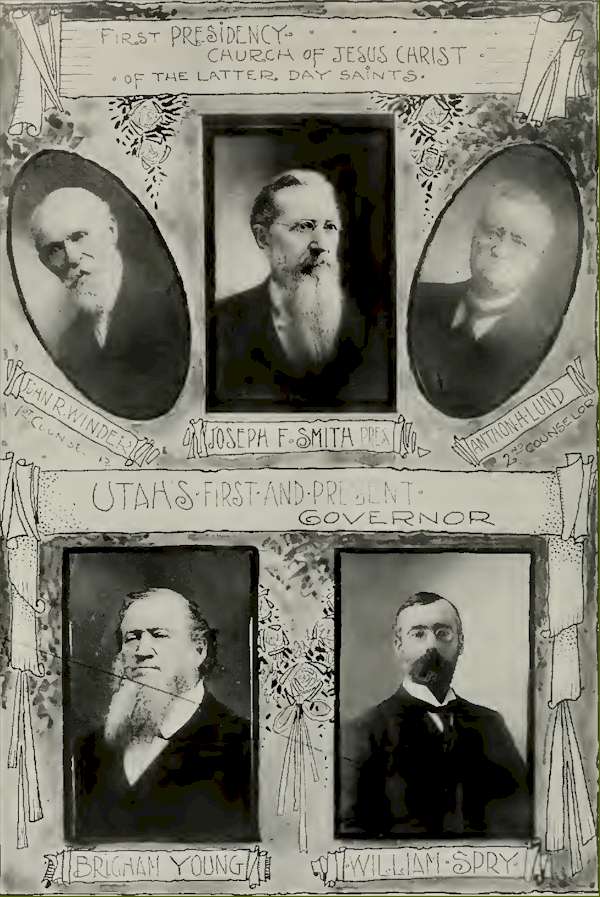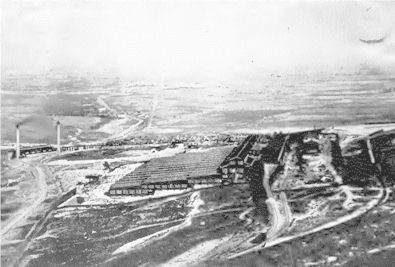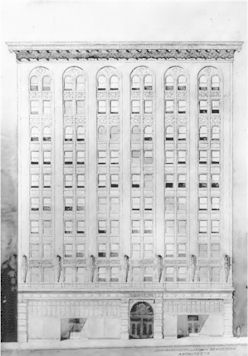Mining and Its Successes
By Horace Dunbar
Contained
within the States of Utah, Idaho and Nevada is a vast mineral
empire, whose resources, imperfectly demonstrated as they are in
proportion to the possibilities, are as abundant and varied as
could be found in any three of the richest and more thoroughly
developed States of the Union.
Although
mining has been carried on in these three States for many years,
there was an extremely wide field to be covered, and it was a
field which sorely tried, but never daunted, the hardy pioneer.
Lack of proper transportation facilities, of adequate mine
equipment, of a ready market for the product of the mines and
the doleful scarcity of nature's great boons to mankind food and
water all have combined to retard the proper exploitation of
this immense storehouse of mineral wealth. And even at this late
day, when one wonders if there really is any pioneering possible
in the West, a person does not need to go far beyond the
railroad tracks to find himself in a wilderness of opportunity
untouched and unclaimed by the hand of man, and equally in a
wilderness where all the comforts of life are wanting.

Gold, silver,
copper and lead comprise the main mineral production of Utah,
Idaho and Nevada. In the early days Nevada was dotted from one
end to another with silver camps. Utah witnessed the climb and
fall of innumerable gold and silver districts which had made
most honorable history for the "West, and Idaho as well has
suffered in many spots from declines in mining. The hardships of
early mining were responsible for this. There are numerous camps
of the West holding mining properties equipped with extensive
and expensive machinery. Much of this machinery was brought
round the Horn by sailing vessels, thence transported across the
deserts by ox teams at a cost of eight cents per pound. The
nearest smelter was in Swansea, Wales, and quite naturally only
the highest grade ore could be mined and marketed. When silver
began receiving death blows at the hands of the governments of
the world all the famous camps were abandoned, and not until
recent years has capital entered into what at one time were
scenes of extensive mining operations which were productive of
countless millions of dollars, which formed the foundation for
the majority of the greatest fortunes of the United States.
On
investigation it was found that all the old camps were teeming
with ores developed by the early operators, but whose
comparatively modest metallic contents precluded sale under
former conditions. Modern metallurgical knowledge and newly
installed reduction works brought these resources into instant
availability, and the rejuvenation of abandoned camps began on
all sides. The early operator also recognized only a few
formations which he knew were productive of the sort of mineral
results he desired. Today geological formations which he
despised are producing returns which surpass results the
old-timer achieved.
Instead of
equipping individual mines with their own reduction works,
capital wisely centered its energies on selecting a central
point where smelting operations could be carried on in a manner
equally beneficial to all. This policy gave to Salt Lake City
the distinction of being the smelting center of the United
States. Within sight of the city the American Smelting and
Refining Company, the United States Smelting, Refining and
Mining Company, the Utah Consolidated Company, the Bingham
Consolidated Company, and the Yampa Company, all were operating
smelting plants up to 1907.
In answer to
litigation instigated by the farming element in the Salt Lake
valley, the courts closed practically all these plants late in
the year mentioned. It was asserted that the fumes from the
stacks destroyed vegetation and animal life. This necessitated
improved devices to prevent smelting operations from injuring
the surrounding farm usefulness, and right successfully have the
smelting companies met the issue. Out of the wrecks have risen
new smelters, until to-day, early in 1909, the American Company
at Murray is operating a lead-silver smelter, and one of the
greatest copper smelters in the world at Garfield, on the shores
of the Great Salt Lake, near Salt Lake City. The United States
Company is smelting silver and lead ores at Bingham Junction.
The Yampa Company is treating its own ores at Bingham, and in
Tooele County, near the Great Salt Lake, the International
Smelting and Refining Company is spending millions of dollars in
rushing to completion one of the largest and most modern copper
smelters in the world. In addition, there is a
silver-lead-copper smelter in Tintic, Utah, and a copper smelter
at Ogden.
Among the old
camps once famous, and now revived to tremendous activity and
success are Bingham, Utah, and Ely, Nevada, both copper camps of
magnitude. In each camp huge mountains of low-grade copper ore
are being eaten down by scores of steam shovels, the ore being
hurried via special railroad lines to mammoth concentrating
plants, where the low-grade porphyry ore is concentrated to a
grade which admits of profitable smelting. Pioche, Nevada, a
one-time richly productive silver-lead camp, today is answering
the call of capital with splendid ore developments, while in all
the three States new camps spring up from day to day, which
illustrates how imperfectly the field has been covered.
Idaho stands
out distinctively as one of the great lead-producing States of
the Union, the Coeur d'Alene district being the most famed lead
camp in the world. Unlike most lead camps, whose heavy metal
values give way at depth to copper or some other metal, nothing
but lead, and in ever increasing quantities, has been found with
the deepest of work. Nevada during the past five years has
astonished the world with its discoveries of new gold fields,
following closely on which finds have been the extensive and
successful development of silver, lead and copper camps.

Utah Copper Mill
The following
statistics will show the mineral standing of the three States,
the figures being taken from the year 1907, owing to the
incomplete statistical record for 1908:
In 1907 Utah
stood fifth in rank of the gold-producing States of the Union,
producing 247,758 ounces value, $5,121,600; second in silver
production, with an output of 11,406,900 ounces value,
$7,528,500; third in lead production, with an output of 54,738
tons; fourth in copper, with an output of 68,333,115 pounds.
Idaho ranked
ninth in gold, with an output of 60,754 ounces value,
$1,255,900; fifth in silver, with an output of 7,888,400 ounces
value, $5,206,300; second in lead, with an output of 111,697
tons; seventh in copper, with an output of 11,471,101 pounds.
Nevada ranks
fourth in gold, with an output of 745,507 ounces value,
$15,411,000; fourth in silver, with an output of 8,280,500
ounces -value, $5,465,100; sixth in lead, with an output of
3,400 tons; eleventh in copper, with an output of 1,462,450
pounds.
The first
large, low-grade, low-cost copper producer of Utah to emphasize
its merits by entering the dividend-paying column was the Utah
Copper Company of Bingham. Following closely on its heels is the
Boston Consolidated Company, with the Ohio Copper Company on the
verge of operations in its new milling plant. These great mines
are just coming into their own, and the year 1909 should find
the copper output for Utah reaching well above the
100,000,000-pound mark. Throughout the State are numerous new
copper camps which are developing fast, and vast sections are
known to exist where nothing but the wise application of capital
will open red metal mines of magnitude.
In Ely,
Nevada has one of the mammoth low-grade copper camps of the
world, and gigantic concentrating plants and smelters near the
mines are now in highly successful operation. The next extensive
copper camp of Nevada is known as the Yerington District, but
legally named the Mason Mining District. Yerington, unlike
Bingham and Ely, contains straight smelting copper ores which
require no preliminary treatment before they are fit for the
smelter furnaces. This dispenses with the installation of
expensive concentrating mills, taking less capital to reach the
coveted goal of production. Other copper sections of Nevada are
being brought prominently to the attention of the world, and
that there are other Elys and Binghams in the two States is
demonstrated by the liberal expenditures of money now seen on
all sides. Recent developments in heretofore untouched portions
of Idaho prove that an enormous field awaits the activities of
the prospector and investor in its mineral-ribbed mountains. New
railroads and new wagon roads continually are being built to
sections which once were inaccessible.
In addition
to their wealth of mineral deposits, the hills of Utah are
seamed with high-grade coal, another undeveloped field which
needs only the magic hand of capital to add millions each year
to the output of the State. Regarding the coal deposits of Utah,
the seventh report of the Bureau of Statistics of the State of
Utah, for 1907-1908, uses the following language:

Kearns Building, Salt Lake
City
"The
coal-mining industry as reported by Mr. Petitt, State Coal Mine
Inspector, is in a most thriving condition, due in a great
measure to the settled labor conditions which have been
maintained in the various mining camps for the past few years.
The production has increased in quantity and value during the
past five years. There is, however, much room for improvement in
these respects, more particularly when one considers the
enormous extent of the coal areas of the State.
"The coal
area known as the Book Cliff (Wasatch field), extending" east
and west from Castle Dale, in Carbon County, to the Colorado
line, and south to the southeastern part of Sevier County,
covering approximately 1,600 square miles, is considered both in
respect to thickness and development the most important coal
field in the State. Other coal areas are: The Coalville or Weber
River field in Summit County; in the northeastern portion of the
State, the Henry's Fork and Ashley Creek coal area; large coal
areas in Uintah County; the Henry Mountain District, and in the
southwestern portion of the State the Colob plateau, showing the
wide distribution of coal lands in the State. ''
In eastern
Utah lies one of the most valuable and extensive hydro-carbon
deposits in the world. One of the principal products from this
seldom-mentioned field is asphaltum, while from these deposits
are made paints, mineral rubber, medicines and numerous other
materials which find their way into the world's commerce.
Oil of the
finest quality, and in a sufficient quantity to justify the
expenditure of hundreds of thousands of dollars annually, is
being developed in San Juan County, Utah, while the Virgin field
in southern Utah gives promise of becoming an important oil
center of the West.
The "Mining
World" of Chicago, in its issue of April 3, 1909, gives the
names of forty-one dividend-paying mining companies in Utah;
twenty-five in Nevada and seven in Idaho. In the Silver King
Coalition Mines Syndicate of Park City, Utah, the State during
the first quarter of 1909 held the greatest silver-lead
dividend-paying company in this hemisphere. Considerably over
one hundred millions of dollars have been distributed to
stockholders in the shape of dividends by Utah mining companies
since any record was taken, which excludes close corporations
not giving to the world their profit sharing.
In spite of
the great production of the three States which compose this
empire, and in spite of the many new fields continually
springing into fame, a virgin territory awaits the man of money
and brains within their boundary lines. New problems confront
the mining and metallurgical engineer, offering a remunerative
opening for numerous experts from year to year, which cannot
help but attract the young and ambitious the world over. These
States are merely in the bud, and present an ideal opportunity
for safe and constant investment.

Index

Source: Sketches of the Inter-Mountain
States, Utah, Idaho and Nevada, Published by The Salt Lake
Tribune, Salt Lake City, Utah, 1909
|


